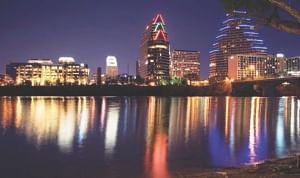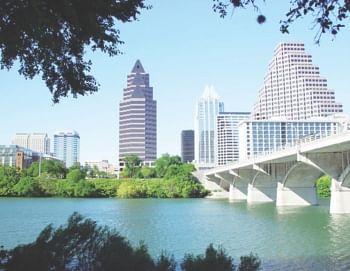| Home - Back Issues - The Team - Contact Us |
 |
| Volume 11 |Issue 44| November 09, 2012 | |
|
|
Perceptions Developing a Dynamic Downtown District Tamim Chowdhury
As I sit in a dimly-lit lounge patio alongside bustling Congress Avenue, sipping on a cool drink on a cooling Texas spring evening, I look around Austin's vibrant hotspot at the stylish nightclub-goers with body-hugging clothes, casual travellers in khakis, and tattered T-shirt wearing, homeless pedestrians, all sharing the same space beneath the starry skyline. This is downtown, the shared space for the elite and masses, the setting for Austin's socioeconomic and political landscape. In spring 1838, Texas Vice President Mirabeau Lamar declared the Austin area as capital of the Lone Star State. Downtown's origins are from 1839, when Judge Edwin Waller created the grid layout plan for the city's four public squares and the Capitol square. Today, the area holds Greek Revival homes from 1850s, Victorian-era masonry commercial buildings, Chicago-style skyscrapers, and modern architectural landmarks. The approximately 1,000-acre downtown is bound by Colorado River on south, MLK Jr. Boulevard on north, Interstate Highway 35 on east, and Lamar Boulevard on west. Downtown's subareas include single-family neighbourhoods, such as the prestigious Judges Hill, a historic area with grandstanding homes on rolling hills. Lady Bird Lake within the Colorado River system is the catalyst in bringing more commercial and residential developments into downtown. The lake system came about as dams were constructed in Colorado River in 1893, as a measure to prevent flooding. The hike-and-bike trail at Lady Bird Lake was a vision by First Lady Johnson; she wanted a pathway for the riverbanks. In 1964, UT Architectural School Dean Allen Tanaguchi started designing the Town Lake Master plan, which envisioned parklands alongside the 10-mile water body. Trail beautification began in 1970, with the First Lady planting crepe myrtle trees in 1971. Soon enough, a treeless, surprisingly-desolate riverbed was transformed into a flourishing parkland. Since the 1990s, downtown has become a residence for thousands who live as well as work and play here. This is now the epicenter for creative expression in the form of art, music, theatre, and dance; the rich human capital and unique sense of place usher in innovative enterprises. Austin's billion-dollar live-music industry thrives here, bringing in a burgeoning creative class. The City of Austin has followed a master plan that ensures historic preservation, supports a pedestrian-friendly urban district, maintains a dense area with sustainable buildings, interconnects public parks, open spaces, and streets, develops a multimodal transportation system, and provides phased infrastructural upgrades. Transportation includes Capital Metro's 32-mile rail service which reaches the suburbs of Leander. Austin's skyline dramatically evolved since 2000, adding approximately 4,800 apartment and condominium units, according to Capitol Market Research. These include landmark skyscrapers like the 56-story Austonian, 44-story 360 condominiums, and 37-story W Austin Hotel and Residences. These residences pulled in more restaurants and retail into the area. Perry Lorenz and the late Robert Barnstone were pioneering developers who built the Nokonah, an 11-story, 99-unit luxury condominium that launched in 2002. Although initially met with skepticism, this led to an explosion of developments in the area.
Former Mayor Will Wynn stated, “Downtown is really firing on virtually every cylinder residential, retail, entertainment, employment.” Mayor Wynn was an early, crucial advocate of a dense urban core. He continued, “With high-density, mixed-use urban development, water use, electricity use, and vehicle miles traveled per capita all plummet.” As mayor from 2003 to 2009, Wynn advocated for a dense downtown. According to the Urban Land Institute, Austin is creating an economy of the future by pulling in well-educated, creative, entrepreneurial risk-takers that run or are employed by businesses that build well-paying jobs. Currently, about 9,800 residents reside in downtown, paying monthly rent ranging from $1,865 to $10,000 or owning the property, which costs from $240,000 to $4 million, according to Austin American-Statesmen newspaper. Real estate consultant Charles Heimsath noted that downtown dwellers fall into four categories: Young, downtown-working professionals, couples with one downtown worker, empty nesters, and retired couples with dual homes. Back in 1998, former Austin Mayor Kirk Watson advocated for a digital downtown district. He noted, “My argument was that to have a vibrant downtown and vital space, you need to have the new economy. Let's start by getting this knowledge-based economy here.” Downtown's evolution over the past decade has made this a preferred destination for Austin's software and multimedia firms. The area has been marked as Austin's technological startup center, with firms building e-commerce software and digital photography having downtown roots. Once the only center of state government, law firms, and banks, downtown now has a diverse workforce. If one requires proof of tech firms setting up in downtown, look no further that Facebook, which has its Austin office right here. Other grandstanding tech firms include HomeAway and Silicon Laboratories. Real estate firm Jones Lang LaSalle's Senior Vice Presidentt Jeff Pace remarked, “If you want to attract and retain that young, highly educated workforce, you want to be in the center of where things are happening.” According to real estate broker Pace, downtown is 40 to 60% more expensive than the suburbs. The expense combined with lack of available space push away some firms. However, the energetic beat of downtown, with its live music, riverside walkways, and arts scene is gaining national attention. As a sign of the post-recession, one can once again see construction cranes, jackhammers, and cordoned-off areas across the downtown landscape. Austin American-Statesman reports that approximately 500 apartments and 1,300 hotel rooms are currently under construction. These include the 18-story, 222-apartment Gables Park Plaza II and the $300-million, 33-story, 1,012-room JW Marriott Hotel. Planned projects include: The city's first planetarium within a 47-story mixed-use tower (live long and prosper), a new Whole Foods headquarters (yeah for the foodies), and a redevelopment of the decommissioned power plant into a 28-story apartment tower plus low-rise retail/office building (finally, put some good use into this juggernaut). Even The New York Times ran a feature on Austin downtown's post-recession growth. In my four years living in Austin, I have witnessed the gravitational pull of this medium-sized downtown. Driving in from south into the tree-lined Congress Avenue, one sees the uninterrupted view of the grandstanding Capitol, the seat of Texas Legislators, from miles away. Somehow, this scene is still breathtaking after all this time. The remarkable views of winding Colorado River and Austin's abundant greenery are seen from the high-rises; the views are almost justifiable for the prices. Strolling across Lady Bird Lake's hike-and-bike trail, I am amazed by Austin's sights. Mothers running with their babies in strollers, senior citizens kayaking with all their might, a jazz player blowing away tunes under the bridge, an independent film being shot with a good-looking couple walking together, these are everyday scenes seen from the riverside. As the Spanish Guitar player electrifies the audience with his tunes, I turn towards the center of the lounge. My cool drink is finished and it's time to leave. I nod goodbye to the long-haired guitarist in leather clothing, and hope to come back to this mesmerizing place one more time.
|
||||||||
Copyright
(R) thedailystar.net 2012 |

